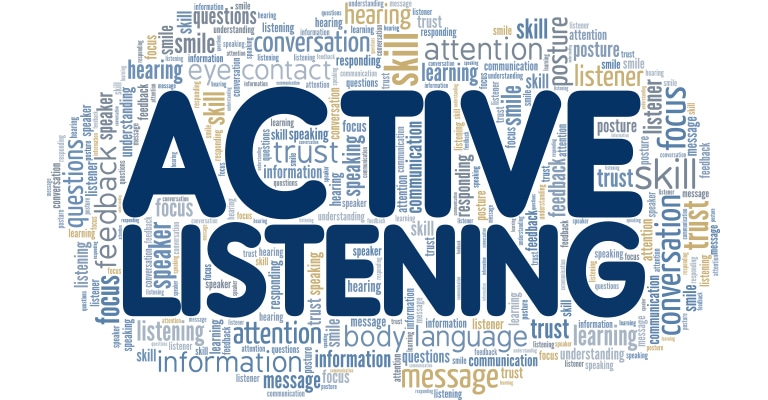Effective leaders know when to talk and when to listen. While many leaders can share their vision, few have learned how to genuinely listen. Active listening sets great leaders apart from good leaders. When you listen well, you hear more than words. You grasp the real meaning, build trust, and make room for new ideas.
Today’s busy work world makes good listening more needed and harder to do. Most leaders rush to make quick choices to deliver fast results. This often means cutting talks short and missing the chance to listen. The cost here is the loss of valuable insights, which results in team members feeling ignored. Furthermore, the absence of active listening often hinders efforts to solve real problems.
Active listening helps in two significant ways. It gives you better facts for smarter choices and builds team trust. People who feel heard typically speak up about problems and work harder toward team goals.
This post discusses why active listening is essential for above-average leadership and how current and future leaders can develop this vital skill.
What Is Active Listening?

Active listening means more than just hearing words. It’s dedicating your full attention to the speaker – it’s trying to grasp their whole message. When you listen actively as a leader, you absorb and process the words and feelings.
Active listening requires your entire focus. This means putting your phone away, establishing eye contact, and showing you’re fully present. Don’t cut in or plan what to say next while you listen. Just take it all in.
Key parts of active listening include:
- Showing genuine interest
- Not cutting people off
- Asking meaningful follow-up questions
- Providing feedback that builds on ideas
- Summarizing what you heard to check you heard correctly
The gap between poor and great listening is similar to that between poor and excellent leadership.
Why Active Listening Creates Stronger Leaders
Good leaders know that real listening creates huge value. When you truly hear your team, you learn things you’d miss otherwise. These insights lead to better choices.
Listening builds trust too. When staff feel heard, they feel more loyal to you and the team. This trust opens the door to honest talk, which you need when times get tough.
Active listening helps you:
- Spot problems early
- See chances others miss
- Connect better with your team
- Make smarter choices based on more views
- Create a place where new ideas grow
Studies show that leaders who listen well get better results. Their teams feel more engaged. They like their jobs more. They get more done.
The Business Impact of Active Listening
Listening well helps your bottom line. When leaders listen, info flows freely. This cuts down on costly mix-ups and mistakes.
Teams with good listeners solve problems better. They fix root causes, not just quick patches. This leads to lasting fixes and fewer repeat issues.
Best of all, good listening sparks new ideas. When people feel heard, they share more fresh thinking. This edge keeps you ahead of the pack.
The money side matters too. Teams with good listening cultures tend to have:
- Less staff turnover
- Happier customers
- Lower conflict costs
- Better follow-through on plans
- More skill at handling change
In today’s fast-paced world, these gains boost your results and profits.
Common Barriers to Active Listening

Even though it matters, listening isn’t always easy. Many things can block good listening. Here are a few of the more frequent limitations:
- Time constraints: When you’re busy with tight deadlines, you might rush talks or try to do two things at once. This splits your focus and wrecks your listening.
- Bias: Leaders often hear only what fits their preconceived notions. They tune out views that don’t match theirs, which limits learning and new ideas.
- Hierarchies: Due to your organization’s structure, those under your leadership may hold back. Bosses may dismiss input from less senior people, stopping good information from flowing.
- Digital Noise: Alerts, emails, and pings disrupt your focus. Good listening takes effort to tune these out.
Recognizing these blocks is the first step to fixing them. Overcoming these hurdles typically requires an honest effort, but it isn’t impossible.
Five Techniques to Improve Your Active Listening Skills
Getting better at listening takes practice.
Here are five tips:
- Be fully present: Clear your mind before key talks. Put devices away. Close extra tabs. Focus just on this talk. This mental reset boosts your listening power.
- Ask great questions: Good questions show you care and help you learn more. Skip yes/no questions. Use open ones that ask “what” or “how” to get richer answers.
- Sum up what you heard: Recap in your own words now and then. This shows you’re tracking and checks that you got it right. Try “What I hear you saying is…” or “So it sounds like…”
- Watch for body language: Words are just part of the story. Notice faces, tone, and posture too. These often tell you things that words alone miss.
- Set up for success: Create spaces that help listening work. Pick quiet spots for key talks. Set rules that help everyone share. Model good listening yourself.
Start with just one of these tips. Practice until it feels natural. Then add another.
How to Implement Active Listening in Your Leadership Routine

To fully embrace and practice active listening you must weave it into your daily routine.
Look for these chances to practice:
- One-on-ones: Aim to listen for at least 70% of the time. Start with a good open question, then open your ears and listen.
- Team talks: Try having each person share for a set time without any breaks. As the leader, take notes and reference each person’s contributions.
- Feedback sessions: When receiving feedback, resist the urge to defend. Instead, listen, say thank you, and consider the full picture before replying.
- Customer chats: Strive to fully grasp their needs and understand their position before implementing potential solutions.
- Cross-team meetings: Each group has its internal language and concerns. Good listening helps bridge these gaps.
You’ll slowly change how you lead by using these chances to practice.
Measuring the Impact
How can you tell if your listening work is paying off?
Watch for these signs:
- More team input often means better listening. When people feel heard, they speak up more. Look for quiet team members starting to share.
- Better quality info comes as trust grows. Staff will share hard truths and fresh ideas when they trust you’ll really listen.
- Fewer mix-ups and clashes tend to happen with better listening. Work flows more smoothly when concerns get aired early on.
- Higher staff scores often link to leaders’ listening skills. If you track staff scores, better numbers may show your listening is working.
- More diverse views emerge when active listening is the norm. As people feel safer, those from all backgrounds become more comfortable and are willing to share their individual takes.
Set some listening goals and track these signs to gauge how you’re doing.
Conclusion: The Listening Leader Advantage
In a work world full of loud voices and strong views, active listening gives you a real edge. When you truly listen as a leader, you tap into group wisdom that goes far beyond what any one person knows.
Top leaders know that listening isn’t passive—it’s one of the most active tools they have. By giving others your full focus, asking smart questions, and taking in diverse views, you build a place where both people and ideas thrive.
As your listening skills grow, you’ll see good changes spread through your team. Trust will deepen. New ideas will flow faster. Work will get done better. All this comes from your choice to listen more than you speak.
Remember that becoming a great listener never ends. Each talk gives you a new chance to practice this key skill. By choosing to listen well, you boost both your impact as a leader and your team’s success.
What’s one listening chance you’ll take today?



